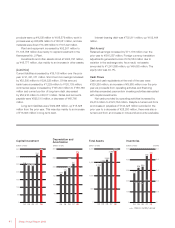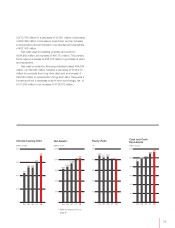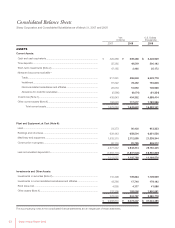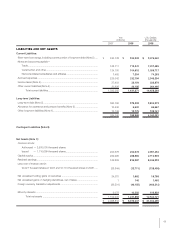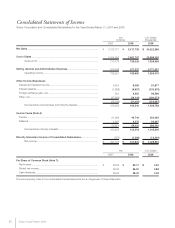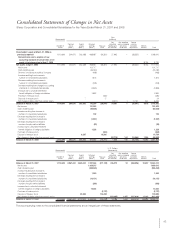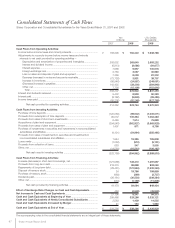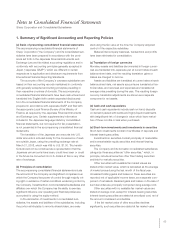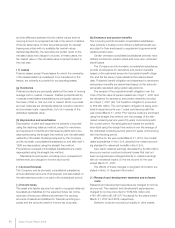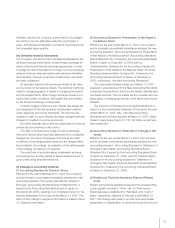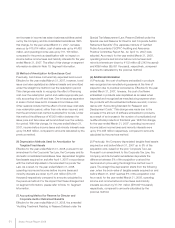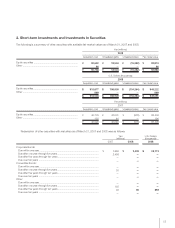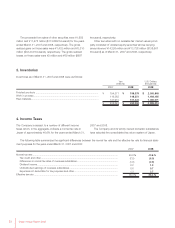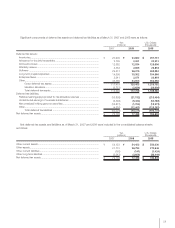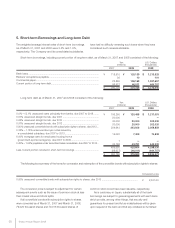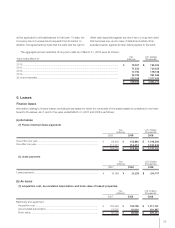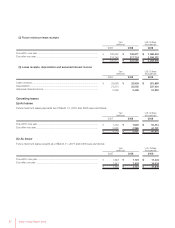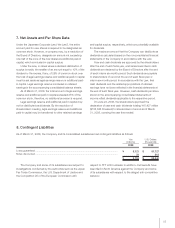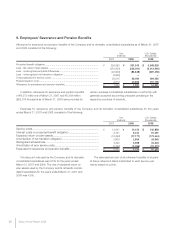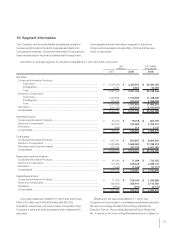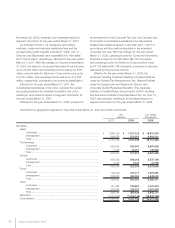Sharp 2008 Annual Report Download - page 52
Download and view the complete annual report
Please find page 52 of the 2008 Sharp annual report below. You can navigate through the pages in the report by either clicking on the pages listed below, or by using the keyword search tool below to find specific information within the annual report.
51 Sharp Annual Report 2008
rent increase in income has arisen business activities carried
out by the Company and its consolidated subsidiaries. With
this change, for the year ended March 31, 2007, net sales
were up by ¥15,614 million, cost of sales was up by ¥4,458
million, and operating income was up by ¥11,156 million,
compared to the previous classification with no impact on
income before income taxes and minority interests for the year
ended March 31, 2007. The effect of this change on segment
information is stated in Note 10. Segment Information.
(5) Method of Amortization for Bond Issue Cost
Previously, bond issue cost was fully expensed as incurred.
Effective for the year ended March 31, 2007, however, bond
issue cost was capitalized as deferred assets and amortized
under the straight line method over the redemption period;
This change was made to recognize the effect of financing
cost over the redemption period and realize appropriate peri-
odic accounting of profit and loss. One is because expansion
in scale of bond issue led to increase in bond issue cost.
Other reasons include that the effect of bond issue cost lasts
over redemption period, rather than only when incurred, and
that the amortized cost method is adopted for bonds. Under
this method the difference of ¥5,000 million between the
issue price and face value will be amortized over the redemp-
tion period. With this change, for the year ended March 31,
2007, income before income taxes and minority interests was
up by ¥4,865 million, compared to amounts calculated by the
previous method.
(6) Depreciation Methods Used for Amortization for
Tangible Fixed Assets
Effective for the year ended March 31, 2008, pursuant to an
amendment to the Corporate Tax Law, the Company and its
domestic consolidated subsidiaries have depreciated tangible
fixed assets acquired on and after April 1, 2007 in accordance
with the method stipulated in the amended Corporate Tax
Law. As a result, for the year ended March 31, 2008,
operating income and income before income taxes and
minority interests are down by ¥7,234 million ($73,071
thousand) respectively compared to amounts calculated by
the previous method. For the impact that these changes had
on segment information, please refer to Note 10. Segment
Information.
(7) Accounting Method for Reserve for Director and
Corporate Auditor Retirement Benefits
Effective for the year ended March 31, 2008, the amended
“Auditing Treatment Relating to Reserve Defined under the
Special Tax Measurement Law, Reserve Defined under the
Special Law and Reserve for Director and Corporate Auditor
Retirement Benefits” (The Japanese Institute of Certified
Public Accountants (“JICPA”) Auditing and Assurance
Practice Committee Report No. 42, April 13, 2007) was
adopted. As a result, for the year ended March 31, 2008,
operating income and income before income taxes and
minority interests are down by ¥133 million ($1,343 thousand)
and ¥896 million ($9,051 thousand), respectively, compared
to amounts calculated by the previous method.
(o) Additional information
(1) Previously, the cost of software embedded in products
was recognized as manufacturing expense at the time of
inspection due to practical convenience. Effective for the year
ended March 31, 2007, however, the cost of software
embedded in products was capitalized as an asset when
inspected and recognized as manufacturing expense when
the products with the embedded software are sold, in accor-
dance with “Accounting Standard for Research and
Development Costs.” This change was made due to the
increase in the amount of software embedded in products,
as a result of an increase in the number of complicated and
multifunctional products in this fiscal year. With this change,
for the year ended March 31, 2007, operating income and
income before income taxes and minority interests were
up by ¥10,455 million respectively, compared to amounts
calculated by the previous method.
(2) Previously, the Company depreciated tangible fixed assets
acquired on and before March 31, 2007 up to 5% of the
acquisition cost, based on the prior Corporate Tax Law.
Pursuant to an amendment to the Corporate Tax Law, the
Company and its domestic subsidiaries depreciate the
difference between 5% of the acquisition cost and the
memorandum price using the straight line method over 5
years. The straight line depreciation starts from the following
year, when the book value of tangible assets acquired on and
before March 31, 2007 reaches 5% of the acquisition cost.
As a result, for the year ended March 31, 2008, operating
income and income before income taxes and minority
interests are down by ¥7,791 million ($78,697 thousand)
respectively, compared to amounts calculated by the
previous method.


